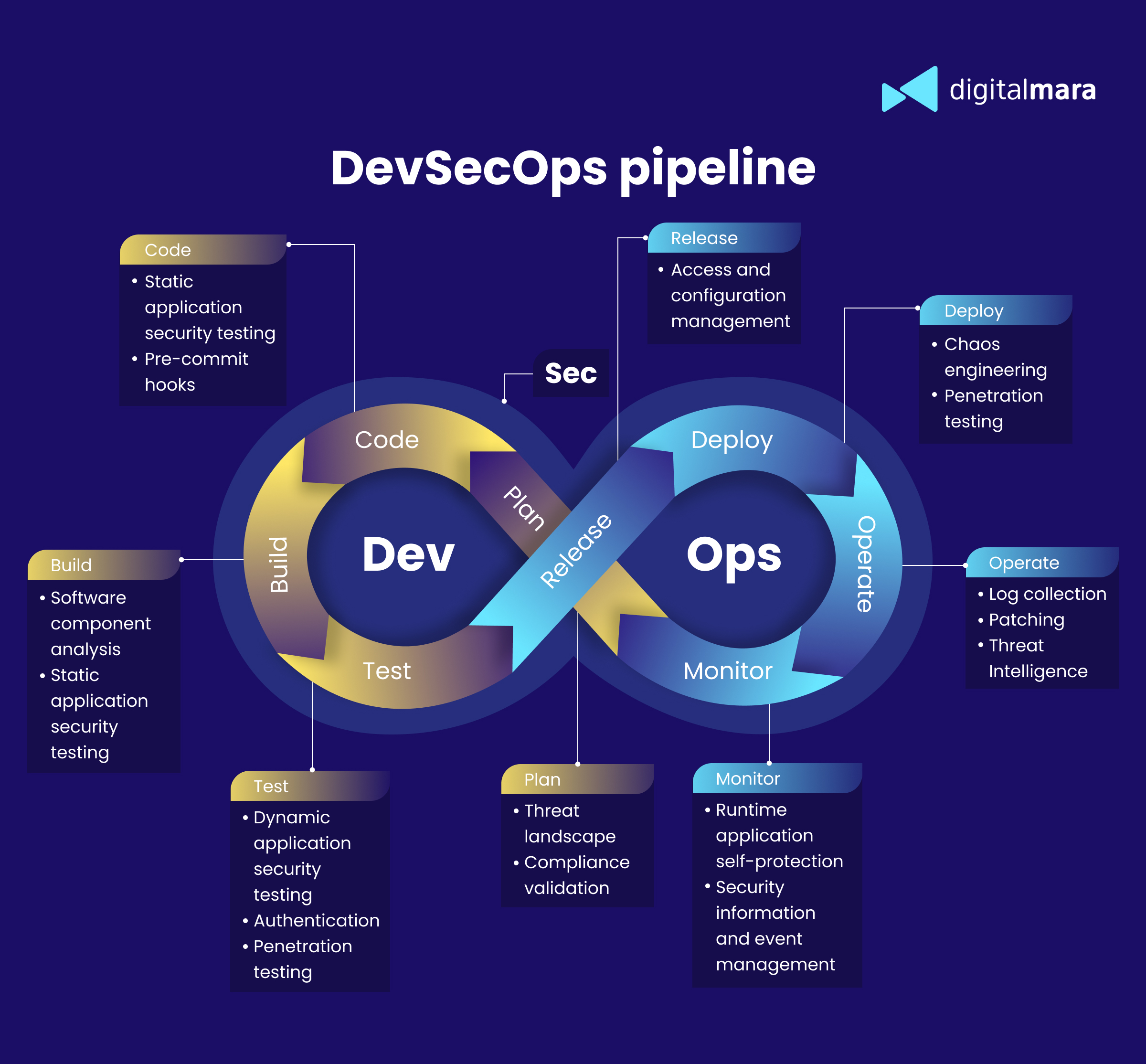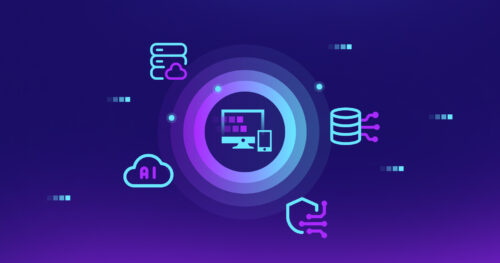For the last couple of years, we’ve seen a transition from slowly deployed on-premises infrastructure to a dynamic cloud environment. Software development and all related processes are becoming more agile and flexible, and approaches to organizing operations and security must be adapted to these changes. DigitalMara has taken a look at the state of DevOps and its transition to DevSecOps. We compared these two specializations and outlined cases when your project needs DevOps or DevSecOps.
When developing software, companies and organizations either rely on their internal teams or turn to software development agencies. In both cases, it’s important to understand the principles of team formation, and that your team can’t be limited to developers and testers. To create and maintain code efficiently and deliver robust applications, it’s crucial to have DevOps. These specialists are responsible for quality deployment, including in the cloud, monitoring, automation implementation, maintaining pipelines, responding to and managing incidents and communication with other team members.
The spread of cloud development, increase in cyberthreats, and shift to shorter and more frequent iterations in development have changed the modern development ecosystem. And DevOps has evolved into the subsequent stage of DevSecOps, which completely surrounds the development lifecycle with security measures.
Inherently, DevOps and DevSecOps have different main goals, but both strive to improve your processes and outcomes. They are based on a similar culture and work with automation and active monitoring.
What is DevOps?

DevOps refers to a development and operations concept, aiming to establish a consistent development environment, automate the process of delivery and make it efficient, stable and predictable. Bringing together development and operations teams, it ensures the software product doesn’t just work, but works in real-world conditions and with real users. Software quality is improved due to easier error detection and fixing. The overall lifecycle is accelerated, as development and testing are performed simultaneously.
DevOps empowers the team. Developers get more evidence about and understanding of the production environment, and can control the production infrastructure even more. These practices make it possible to enhance the speed and quality of software delivery thanks to frequent, regular, small releases of software updates. For example, with server build automation, there is no need to rebuild every time you push code changes into production. Automation also reduces the possibility of human error.
To sum up, this approach allows for delivering new features as quickly as possible without compromising quality. This represents a great opportunity for companies that release updates often and need to do so promptly. DevOps establishes tight connections and constant communications between teams. However, this does not negate the possibility of delays and backups. So, one of the drawbacks is that it can be tricky to embed in big companies, where processes and procedures are already established.
What is DevSecOps?

DevSecOps stands for development, security, and operations. In practice it means adding a security layer to every stage of the software development lifecycle – from planning to design to testing and deployment. The main goal is to decrease risks and vulnerabilities to deliver quickly and improve the quality of software. Cloud development requires specific security guidelines and practices, which makes DevSecOps a vital element. For example, thanks to security audit automation, you won’t need to manually evaluate your system for vulnerabilities. Automation also significantly accelerates response time when an incident occurs and ensures greater visibility.
Some general security measures are:
- Keeping absolutely clean code for every update and application;
- Auditing profiles and permission sets; and
- Keeping current actual data backups.
This approach is good for companies that store and handle sensitive data and need to follow strict compliance regulations within their industries. They can still take advantage of a smooth development process and be sure the application is secure and safe. Obviously, there are some drawbacks. DevSecOps implementation may require extra resources and effort, as it is more complex and time-consuming than conventional DevOps. Plus, adding security measures to each stage in some cases may slow down the entire development process.
What distinguishes DevSecOps from DevOps?
DevSecOps is not just a supplement to the traditional DevOps approach. It’s a special set of practices that differ, though they overlap. DevOps focuses mainly on efficiency and technical aspects, while the key concern of DevSecOps is security. The second team is more proactive regarding prevention of cyber threats and attacks, instead of just responding to incidents after they have occurred.

Moving from DevOps to DevSecOps
With increasing usage of cloud and cloud-based services, teams face more complex security issues. These technologies are agile, so it’s crucial to enable security features at every stage of the software development lifecycle. In general, the transition from DevOps to DevSecOps means adopting some security tools and processes. In addition, it means unifying your data and all relevant information in one view.
Some key points are:
- Automation for fast and accurate delivery;
- Continuous overall end-to-end visibility;
- Integrated view of the process;
- Equal treatment of security vulnerabilities and quality defects;
- Constant tracking of all issues; and
- All teams participate in the post-incident response strategy.
Development, security and operations should move forward together, share an integrated view within their area of responsibility, and give the same priority to quality defects and security vulnerabilities. All teams should be involved in resolving an issue and develop a unified strategy. Shared tools and visibility can help here.
Experts assume that the security strategy within DevSecOps will shift to the “zero trust” model, which is based on the concepts of de-perimeterization and least privilege. Teams automatically segment networks to prevent the possibility of any disruption in the network. A disruption in one part of the network will be isolated there, and won’t disrupt normal workflows for legitimate users.
Conclusion
DevSecOps is often considered to be a more comprehensive concept for software development than DevOps, although both serve to enhance efficiency and quality and increase the speed of the software development. When choosing, it’s important to consider your needs and the resources at your disposal.
At DigitalMara we understand both concepts and implement them according to the needs of the particular project. In our team we have both DevOps and DevSecOps professionals, who employ the best practices and tools.

































